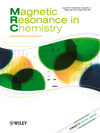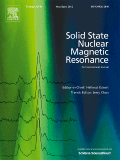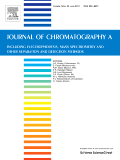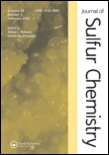
MAGNETIC RESONANCE IN CHEMISTRY
Scope & Guideline
Pioneering Research in Chemistry and Materials Science
Introduction
Aims and Scopes
- Nuclear Magnetic Resonance (NMR) Spectroscopy:
The journal emphasizes research involving various NMR techniques, including 1D and 2D NMR, solid-state NMR, and quantitative NMR, highlighting their applications in structural elucidation and characterization of chemical compounds. - Applications in Natural Products and Organic Chemistry:
Research published in the journal often explores the use of NMR in the analysis of natural products, aiding in their structure determination and characterization, thus bridging chemistry and biology. - Theoretical and Computational Studies:
The journal includes theoretical investigations and computational methods related to NMR, such as density functional theory (DFT) and machine learning applications, pushing the boundaries of NMR analysis and predictive modeling. - Emerging Techniques and Innovations:
The journal showcases novel methodologies and advancements in NMR techniques, including hyperpolarization, signal amplification, and non-uniform sampling, which enhance the sensitivity and resolution of NMR spectroscopy. - Interdisciplinary Applications:
Research in the journal spans various fields, including food science, forensic chemistry, and environmental studies, demonstrating the versatility of NMR as a powerful analytical tool.
Trending and Emerging
- Metabolomics and Biological Applications:
There is a significant increase in research centered around metabolomics, utilizing NMR for real-time analysis of biological samples, indicating a trend towards integrating NMR with biological and medical research. - Machine Learning and AI in NMR Analysis:
The integration of machine learning techniques in NMR data analysis is becoming more prevalent, showcasing a trend towards leveraging computational power to enhance NMR applications and improve data interpretation. - Sustainability and Environmental Applications:
Research focusing on environmental monitoring, food safety, and sustainability using NMR techniques is emerging, reflecting a growing recognition of NMR's role in addressing global challenges. - Innovative NMR Techniques:
There is a rising interest in novel NMR techniques such as signal amplification methods, hyperpolarization, and advanced sampling techniques, demonstrating a push towards enhancing the capabilities and applications of NMR spectroscopy. - Interdisciplinary Research:
An increasing number of publications highlight interdisciplinary approaches, where NMR is applied in diverse fields such as food science, forensic analysis, and materials science, indicating a trend towards collaborative and integrative research.
Declining or Waning
- Traditional NMR Techniques:
There is a noticeable decline in papers solely focused on basic or traditional NMR techniques without novel applications or enhancements, suggesting a movement towards more advanced methodologies. - Stereochemistry Studies:
Although stereochemistry remains an important aspect of chemical analysis, the specific focus on stereochemical assignments using NMR has decreased, possibly due to the rise of computational methods that can supplement or replace these traditional approaches. - Inorganic NMR Applications:
The frequency of publications on inorganic compounds and their characterization using NMR has waned, possibly overshadowed by organic chemistry and biochemistry applications, reflecting a shift in the journal's focus.
Similar Journals

Results in Chemistry
Fostering Collaboration in Chemistry Across BordersResults in Chemistry is a prominent journal published by Elsevier, dedicated to fostering innovation and disseminating cutting-edge research in the field of chemistry. With an ISSN of 2211-7156, this open-access journal has been committed to making scientific knowledge widely available since 2019, aligning with the global trend towards accessibility in research. Based in the Netherlands, it features interdisciplinary studies that span the breadth of general chemistry, contributing significantly to the academic dialogue within the scientific community. Despite currently holding a Q3 ranking in the miscellaneous category of chemistry and occupying the 228th position out of 408 in Scopus rankings, the journal is poised for growth, aiming to enhance its impact and visibility. Researchers, professionals, and students alike will find invaluable resources and insights within its pages, making Results in Chemistry an essential platform for those looking to stay abreast of advancements and trends in chemistry research up to the year 2024.

SOLID STATE NUCLEAR MAGNETIC RESONANCE
Fostering Collaboration in the World of Nuclear Magnetic ResonanceSOLID STATE NUCLEAR MAGNETIC RESONANCE, published by Academics Press Inc Elsevier Science, stands as a prominent journal in the fields of chemistry, instrumentation, nuclear and high energy physics, and radiation, offering a unique platform for researchers and professionals to disseminate their findings and insights. Since its inception in 1992, the journal has continuously showcased innovative research that enhances our understanding of solid-state NMR techniques and applications, contributing significantly to advancements in both theoretical and practical domains. With an impressive impact factor and achieving Q2 rankings across multiple disciplines, it represents a vital resource for academics and industry experts alike, fostering interdisciplinary collaboration and knowledge sharing. While currently not open access, researchers can access valuable content through institutional subscriptions, ensuring a wide reach and influence in the scientific community. The journal's commitment to high-quality publishing makes it a must-read for those at the forefront of nuclear magnetic resonance research.

MAGNETIC RESONANCE IMAGING
Elevating Knowledge in Nuclear Medicine and ImagingMAGNETIC RESONANCE IMAGING, published by Elsevier Science Inc, stands at the forefront of research in the fields of Biomedical Engineering, Biophysics, and Radiology, Nuclear Medicine and Imaging. Since its inception in 1982, the journal has become a vital resource, currently enjoying a Q2 ranking in its respective categories as of 2023, underscoring its influence and significance within the scientific community. With an ISSN of 0730-725X and an E-ISSN of 1873-5894, it provides an essential platform for disseminating groundbreaking studies and advancements in magnetic resonance imaging technology and applications. Researchers, professionals, and students benefit from its comprehensive articles that address both theoretical advancements and practical implementation in clinical settings. The journal's commitment to advancing knowledge is reflected in its recognition in Scopus Rankings, where it lies in the 67th percentile for Radiology, Nuclear Medicine and Imaging. By fostering an environment of critical dialogue and innovation, MAGNETIC RESONANCE IMAGING remains a cornerstone publication for those dedicated to pioneering the future of imaging science.

THEORETICAL CHEMISTRY ACCOUNTS
Empowering Researchers with Open Access to Theoretical BreakthroughsTHEORETICAL CHEMISTRY ACCOUNTS is a prestigious journal dedicated to promoting the advancement of theoretical and computational chemistry. Published by Springer, this journal has become a vital resource for researchers, professionals, and students seeking to explore innovative theoretical approaches in chemistry since its inception in 1996. With a current impact factor positioning it in the Q3 category of Physical and Theoretical Chemistry, it underscores its importance in the academic landscape, ranking 113 out of 189 in its field according to Scopus. The journal embraces an Open Access model, making cutting-edge research widely accessible to the global community. Researchers are encouraged to submit their latest findings and theoretical advancements, contributing to the ever-expanding body of knowledge within this dynamic field. Addressing contemporary challenges and breakthroughs, THEORETICAL CHEMISTRY ACCOUNTS serves as an essential platform for dialogue and discovery among scholars dedicated to the intersection of chemistry and theory.

JOURNAL OF CHROMATOGRAPHY A
Pioneering Insights in Analytical ChemistryJOURNAL OF CHROMATOGRAPHY A, published by Elsevier, is a leading journal in the disciplines of Analytical Chemistry, Biochemistry, and Organic Chemistry, boasting an impressive 2023 Q2 categorization across multiple fields. With an ISSN of 0021-9673 and an E-ISSN of 1873-3778, this prestigious journal has been at the forefront of chromatography research since its inception in 1958. The journal serves as a vital platform for disseminating high-quality research articles, reviews, and insights into the latest developments in chromatographic techniques and applications, reflecting its standing in the top tier of analytical and organic chemistry literature, evidenced by its impressive Scopus rankings. While it currently operates under a subscription model, the journal continues to make significant contributions to the scientific community by fostering collaboration and innovation in chromatography methodologies. We invite researchers, professionals, and students to engage with the essential findings shared within its pages, which are foundational for advancements in various scientific fields, making it an indispensable resource for enhancing chromatographic knowledge and practice.

Journal of Sulfur Chemistry
Advancing Knowledge in Sulfur ScienceThe Journal of Sulfur Chemistry, published by Taylor & Francis Ltd, is a pivotal resource dedicated to the field of sulfur chemistry, offering a unique platform for researchers, professionals, and students alike to explore innovative discoveries and advancements. With an ISSN of 1741-5993 and an E-ISSN of 1741-6000, this journal has been a prominent contributor to the academic discourse since its inception in 2004, converging knowledge and research through the year 2024. Recognized in the 2023 Scopus rankings, it holds a strong position at Q3 in the category of miscellaneous chemistry, ranking #173 out of 408, within the 57th percentile, underscoring its role as a valuable asset in the chemistry community. Although the journal does not currently offer open access, it remains a vital source for novel insights and scholarly articles, significantly impacting ongoing research and education in sulfur chemistry.

JOURNAL OF FLUORESCENCE
Bridging Disciplines Through Fluorescence MethodologyJournal of Fluorescence, published by Springer/Plenum Publishers, is a pivotal interdisciplinary journal focusing on the application and innovation of fluorescence methodology across various scientific domains. With an ISSN of 1053-0509 and an E-ISSN of 1573-4994, this journal facilitates the dissemination of significant research findings from 1991 to 2024. The journal has established itself as a key resource in fields such as Biochemistry, Clinical Biochemistry, and Spectroscopy, demonstrating its importance by maintaining a Q3 ranking in multiple categories in 2023, including Biochemistry and Clinical Biochemistry. While currently not offering open access, the journal's commitment to scholarly rigor is reflected in its Scopus rankings and diverse readership, making it an essential source of knowledge for researchers, professionals, and students engaged in the rapidly evolving landscape of fluorescence research.

JOURNAL OF COMPUTATIONAL CHEMISTRY
Exploring Innovative Solutions in Chemical ResearchThe Journal of Computational Chemistry, published by Wiley, is a premier platform in the fields of computational chemistry and computational mathematics. Established in 1980 and continuing through 2024, this journal serves as an essential resource for researchers, professionals, and students seeking to advance their understanding and application of computational methods in chemical research. With a commendable impact factor and ranking in the top quartile (Q2) for both Chemistry and Computational Mathematics, it boasts impressive Scopus rankings—22nd out of 189 in Computational Mathematics and 102nd out of 408 in General Chemistry, indicating its strong influence within these scientific communities. While it does not offer open access, the Journal of Computational Chemistry remains a vital venue for disseminating groundbreaking research and fostering collaboration in the computational science landscape. For those at the forefront of innovation, staying abreast of the latest findings published here is indispensable for advancing their work in theoretical and applied chemistry.

JOURNAL OF MAGNETIC RESONANCE
Advancing Knowledge in Biochemistry and PhysicsThe JOURNAL OF MAGNETIC RESONANCE, a leading peer-reviewed publication from ACADEMIC PRESS INC ELSEVIER SCIENCE, serves as a vital platform for disseminating cutting-edge research in the fields of biochemistry, biophysics, and condensed matter physics. With an ISSN of 1090-7807 and an E-ISSN of 1096-0856, this journal is committed to publishing innovative studies that explore the principles and applications of magnetic resonance techniques. Ranking in the Q3 and Q2 quartiles across various categories in 2023, it reflects a robust standing within the academic community, especially noted for its contributions to nuclear and high energy physics where it ranks 29th out of 87 journals. The journal's comprehensive scope and emphasis on accessible research make it an essential resource for researchers, professionals, and students alike, facilitating advancements in both theoretical and practical aspects of magnetic resonance. With conversion years spanning 1997 to 2024, the journal continues to uphold its legacy as a cornerstone of knowledge in the best practices of scientific research.

Biomolecular NMR Assignments
Empowering scientific inquiry in biochemistry and structural biology.Biomolecular NMR Assignments is a prominent academic journal dedicated to advancing the field of biomolecular nuclear magnetic resonance (NMR) spectroscopy. Published by SPRINGER, this journal aims to provide a platform for researchers to share significant findings, methodological advancements, and in-depth analyses related to protein structure, dynamics, and interactions through NMR techniques. Although not currently open access, it serves as a valuable resource for those in the fields of Biochemistry and Structural Biology, having established a respectable impact factor reflected in its category rankings within these disciplines. With its coverage spanning from 2007 to 2024, Biomolecular NMR Assignments continues to facilitate the exchange of knowledge among professionals and students, contributing to the growth and enhancement of contemporary scientific inquiry. Explore the intricacies of biomolecular studies in the Netherlands and beyond, where critical insights into molecular behavior and function converge.